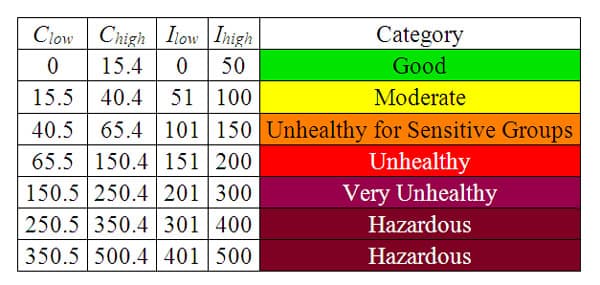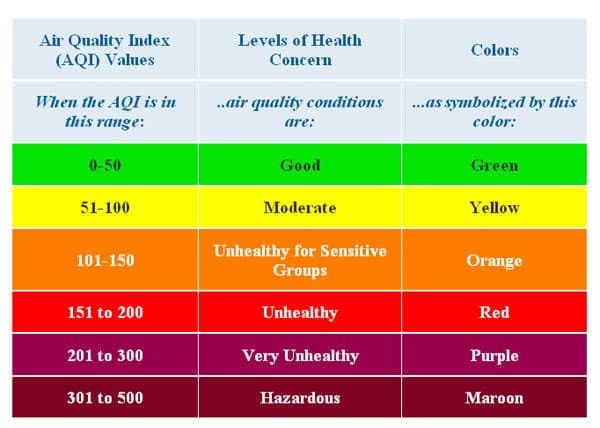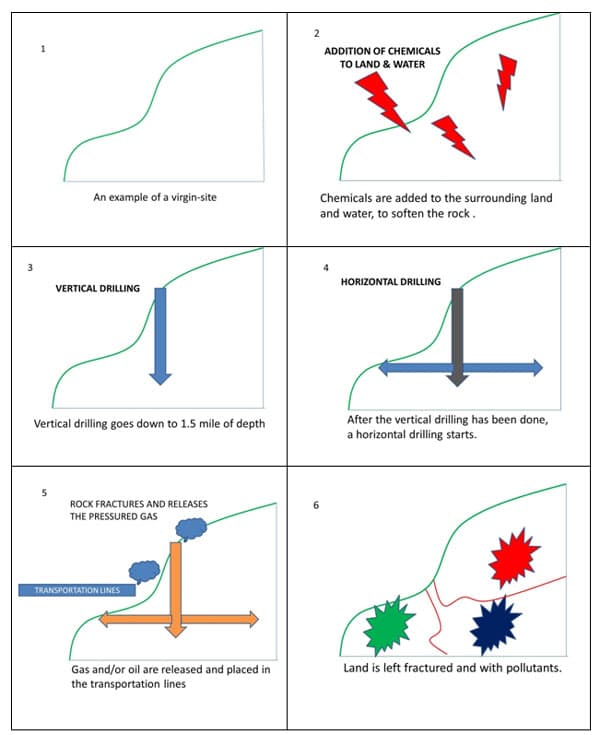2. What is Natural Gas?
Chemically, natural gas is primarily methane, with low concentrations of other hydrocarbons, water, carbon dioxide, nitrogen, oxygen and some sulfur compounds. After the natural gas is processed under high pressure, it turns from gas to liquid, being odorless and with a certain tendency to be white color. Due to the compression processed, it is called "Compressed Natural Gas" (CNG).
2.1 Some Data
The compressed natural gas in the US (CNG) is called in Peru "gas natural vehicular, GNV." Saving money using CNG instead of regular gasoline, is just one of the benefits I have encountered while learning about the use of natural gas. Other immediate benefits are the decrease of the pollution index, cleaner air and therefore, health benefits. The pollution index is in reality called the Air Quality Index (AQI). I will explain a bit more about AQI in section 2.3.
According to the American Lung Association State of the Air 2004 report, more than 160 million of Americans live in areas where the air is polluted and it is dangerous to breathe. Although for more than thirty years the efforts to reduce smog has been one of the main priorities, half of US population still has unhealthy levels of ozone air pollution. In addition, up to 28% of US population breathes air with short-term particle pollution, while 23% of US population lives with year-round levels of particle pollution. 1
The most affected cities in each region, according to the report are:
Northeast: New York City, Philadelphia, Harrisburg, Pa.; Pittsburgh, Washington, D.C.: Newark, N.J., Bridgeport, Conn.; and Baltimore.
Southeast: Atlanta, Birmingham, Ala.; Knoxville, Tenn.; Louisville, Ky.; Charleston, W.V.; Raleigh-Durham, N.C.; and Winston-Salem, N.C.
Midwest region: Chicago, Cleveland, Cincinnati, St. Louis and Detroit.
Southwest: Dallas-Ft. Worth; Houston; and Phoenix
West, Los Angeles: San Diego; San Francisco; Sacramento, Calif.; Fresno, Calif.; Eugene, Ore.; Seattle; Provo, Utah; and Salt Lake City
2.2 Definition of Air Pollution
Since I am continuously referring to air pollution in this document, I will define what air pollution is.
When particles and chemicals mix with the air, we say that the air is polluted. The particles could be carbon monoxide, ozone, nitrates, lead, sulfur dioxide, tobacco smoke vehicle emissions, diesel exhaust, tire fragmentation, road dust, industrial and residential combustion, agricultural and wood burning, power generation, smelting, construction and demolition, windblown soil, pollens, molds, forest fires, volcanic emissions and sea spray. These fine particles are easily inhaled deep in the lungs where they can penetrate the body's defense systems.
According to Norman H. Edelman, MD, consultant for scientific affairs for the American Lung Association, particle pollution is linked to high risk of asthma and heart attacks, strokes, lung cancer and premature death. The same conclusion has been obtained by the National Institute of Environmental Health Sciences (NIEHS) in a combined effort with University of Southern California and the University of Washington.
It is interesting to see all the data related to air pollution vs. lung diseases, and how with prevention, the amount of illnesses can be decreased. According to the estimates on air pollution of the Environmental Protection Agency, by the year 2010, the commitment of new air quality standards and cleaner air will prevent 23,000 premature deaths in the US; 1.7 million cases of asthma will be as well prevented, along with the prevention of 67,000 new cases of acute asthma. The list keeps growing with the prevention of 22,000 hospital admissions of respiratory-related illnesses and 42,000 for cardiovascular diseases.
2.3 The London Smog Disaster and the Clean Air Act
Between December of 1952 and March of 1953, about 12,000 people died mainly from pneumonia, bronchitis, tuberculosis and heart failure. Since the winter was extremely cold, people burned more coal and traveled more by car instead of biking or walking. The car emissions and the fumes from burning the coal, combined with light winds and high moisture, created dense smog consisting of soot, tar and gaseous sulfur dioxide. With light winds, the smog would not move and the high moisture would increase the spreading of the toxic particles, creating a mortal effect. Three years later, in 1956, this disaster would be the reason to create the first "Clean Air Act."
In order to be able to reduce air pollution, the U.S. Congress passed the Clean Air Act in 1990, which was a revision of the 1970 act. Through various regulated reductions in emissions, the act is designed to protect the environment and reduce air pollution. According to the Act, the Environmental Protection Agency (EPA) has the responsibility to protect the quality of the air and the stratospheric ozone layer. Georgia created in 1996 the Georgia Clean Air Force Agency, which is empowered to implement environmental protection measures in the state and follow the standards defined by Georgia's Environmental Protection Division and the EPA.
2.4 Air Quality Index (AQI)
The air quality index is a piecewise linear function of the pollutant concentration. The AQI measures the quality of the air on a scale from 0 to 500. A low number means a good air quality while higher numbers mean worse air.
To convert from concentration to AQI, the following equation is used:

- I = Air Quality Index
- C = Pollutant concentration
- C low = Concentration breakpoint that is ≤ C
- C high= Concentration breakpoint that is ≥ C
- I low = Index breakpoint corresponding to C low
- I high = Index breakpoint corresponding to C high
The Air Quality Index is calculated for a single pollutant. In other words, there are as many AQI numbers as there are pollutants. To compare AQI for different cities, one has to be careful to compare the AQI for the same pollutants.
For example, to illustrate the application of the above formula, I am going to use the average concentration of fine particles known as PM 2.5, recorded in a monitor for a 24-hour period. The reading of the concentration "C" on the monitor is 12.0 micrograms per cubic meter. The table of breakpoints for PM 2.5 is provided by EPA 2 and is given below:

Fine particles PM 2.5 are called like that because their size is less than 2.5 micrometers in diameter. Due to their small size, they can be detected only with a very special microscope called "electron microscope." The sources of fine particles within the PM 2.5 category are combustion of motor vehicles, power plants, residential wood burning, forest fires and other industrial processes. 2a
The formula given above provides an AQI of:

I = (50 - 0)x12.0/(15.4 – 0) + 0
I = 39
Depending on the number obtained for the AQI, a color is assigned. A green color represents a good standing value for an AQI range of 0 to 50. A yellow color is considered moderate for an AQI range of 51 to 100. Orange is in the range of 101 to 150 as "Unhealthy for sensitive groups." Between the values of 151 to 200, in red color, is considered unhealthy. From 201 to 300, with purple color is considered "very unhealthy." From 301 to 500 in brown color is considered hazardous. See table below. 2b
For our example, the result of the AQI is 39 and, therefore, it is placed under the green color category of safe.

I hope to persuade students that conserving our environment is very important. How much can mother earth take from careless people who keep using the resources without looking at the consequences? It is true that the use of certain resources is a great commodity for most of us; and a large part of our society is not willing to let it go that easily. Echo-friendly organizations are trying their best to educate the population to use less resources thinking about the future. Electric and hybrid cars, solar energy, as well as air pollution and car emissions data are just the result of many years of scientific research. We, "The clients," should be aware that we are using resources that in the past were thought to be impossible to of run out of. Now these days, the expression "impossible to of run out of," is not true any longer.
At the beginning of my writing, I was very excited (following media advertisement), that finally, the consumption of oil was going to stop or at least to decrease. In the bright moment of my thinking, I believed that it was just a matter of disseminating the information among the news, schools, and government agencies. I would include as well close friends and family members, who are the hardest to convince.
After doing my research, I found out other information that was not mentioned to me at the beginning of the writing.
Polluted land, contaminated water, improper exploitation of resources, along with improper treatment of toxic waste are the new components of my unit.
New words and expressions for the vocabulary of my science background is piling up. For instance, fracking or hydraulic fracturing, strip mining, sludge, and shale are just part of my new knowledge. I am sure that the lexicon of this unit will continue increasing.
Strip mining and sludge need to be described/ defined before continuing with the narrative. Strip mining is a type of mining done on the surface of a land where several layers of rocks and soil may be found and removed. Sludge is a set of residual of semisolid materials from industrial wastewater or sewage treatment.
2.5 The Conga Project
During a visit to Peru, while doing my research on natural gas, I looked at some of the consequences of extracting natural gas. The land, including rocks, has to be drilled vertically for about 1.5 miles. Some chemicals are added to the water in the area and the mixture is place in the land. The chemicals will soften the soil and the rocks. After the vertical drill, a deep horizontal drilling is done as well, in order to break some of the structures and release the pressured gas. Of course, the chemicals added don't go away. The residuals composed of acid chemicals will stay in the land. See Figure-1.
Suddenly, the land has suffered a severe condition of pollution. The problem does not stay there. Because of the slope of the land, all the pollutants contained in just that particular place, will be flashed down the hill, being mixed with land that was not polluted. Furthermore, the rain will wash the pollutants down to rivers and the pollution just got expanded. A similar exact problem occurs in the mines. One can imagine the consequences of the pollutants in the water. The people who have been living a healthy life may become ill. In this particular place in Cajamarca, Peru; for the last 25 years, the town has been suffering without drinkable water and without electricity. Currently, there are protests from the population who is asking to have part of the earnings dedicated to offer better services, construct hospitals, schools and provide the houses with water and electricity. It is important to mention that the extracting company pays 30% of their earnings to the central government, but the towns do not really see any progress for them.

FIGURE-1
Transportation lines are the tubes set close to the fracking station to transport the gas or the oil extracted. They are part of a pipeline network.
The reason, for which I am including this information about Conga Project in this unit, is because I believe that the general public has to know that on one hand natural gas vehicles are cleaner, but on the other hand, the extraction of natural gas creates pollution. It is important to mention as well that although battery operated vehicles seemed to be the solution to the consumption of oil, the use of Lithium for the batteries are also raising concerns on the extraction of Lithium from the mines. At the end, I believe that we will need to make a choice and pick the least dangerous option, but keeping in mind that there must be a land-remediation process for the land that has been used for mining or gas extraction purposes. For instance, one way to remediate the polluted land is to use sludge combined with wood chips to fill-in the emptiness of a polluted natural gas land or a stripped mine mountain. The application of this remediation actually fits perfectly. However, legislation and politics, along with ignorance on the topic makes it difficult to apply.

Comments: